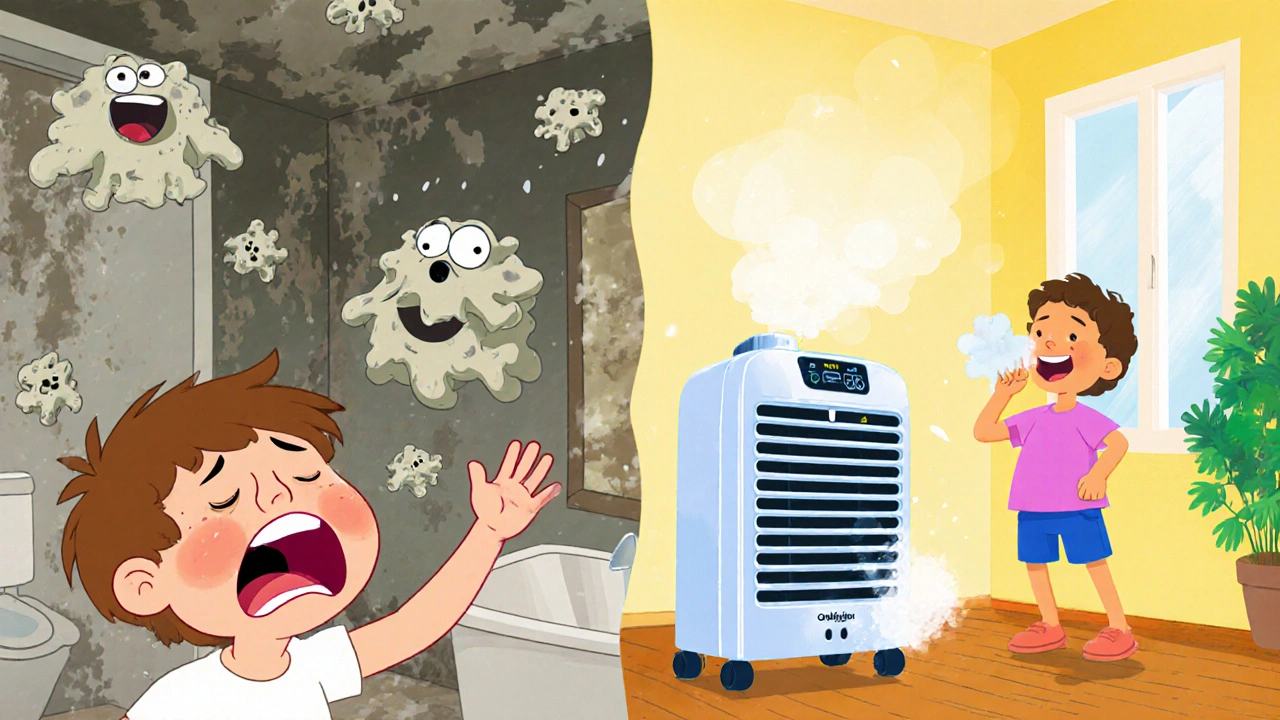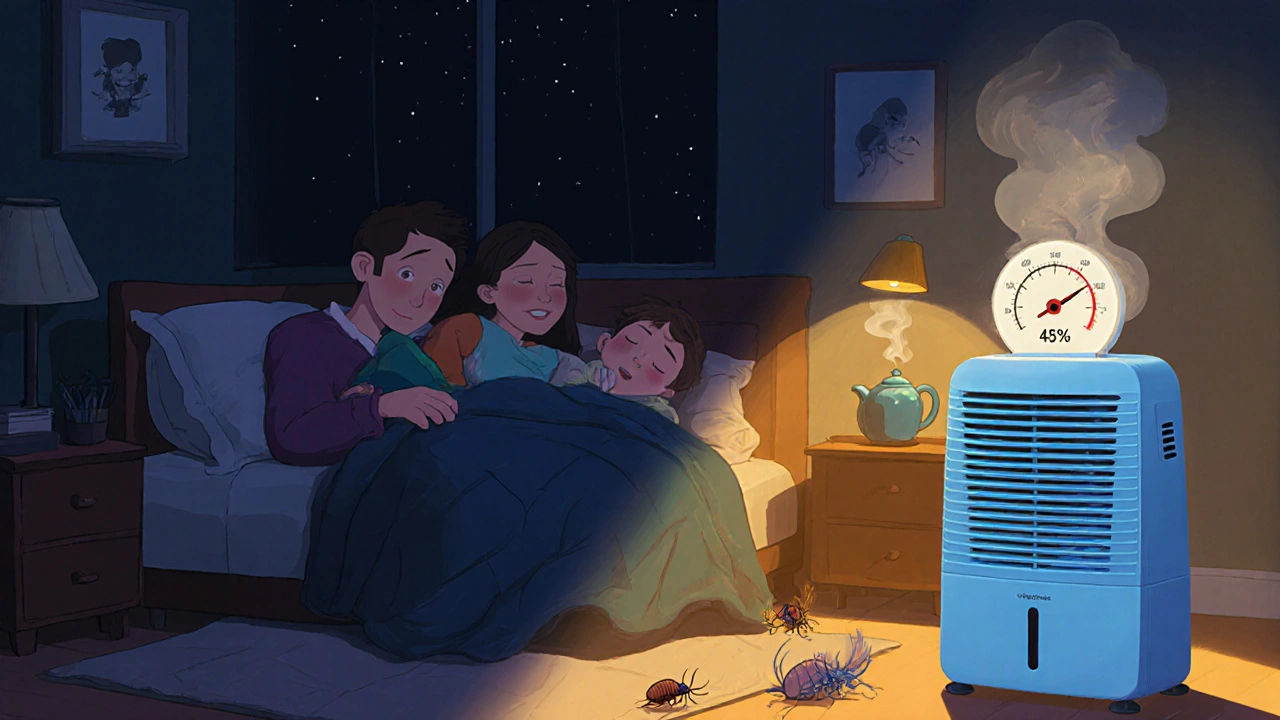If you’re one of the millions who suffer from allergies that never seem to go away-even in winter-you’re not just dealing with pollen. The real culprit might be hiding in plain sight: your home’s humidity levels. Too much moisture invites mold and dust mites. Too little dries out your nasal passages, making them more sensitive to irritants. Getting humidity right isn’t about comfort-it’s about stopping allergies before they start.
Why Humidity Turns Your Home Into an Allergy Trap
Most people think allergies only happen in spring. But if you’re sneezing, coughing, or feeling itchy in December, you’re likely reacting to indoor allergens that thrive in the wrong humidity range. The sweet spot for allergy control is between 30% and 50% relative humidity. Outside that range, your home becomes a breeding ground for trouble.
At humidity levels above 50%, dust mites multiply fast. These microscopic bugs feed on dead skin cells and live in mattresses, carpets, and curtains. A single gram of dust can hold up to 10,000 dust mites-and their feces are one of the most common triggers for year-round allergic rhinitis. The UK’s damp climate makes this worse, especially in older homes with poor ventilation.
High humidity also encourages mold growth. Mold spores float through the air and settle in bathrooms, basements, and behind walls. In Manchester, where rain is frequent and indoor heating is constant, condensation builds up on windows and in corners. That’s not just a cleaning issue-it’s a health hazard. The NHS links prolonged mold exposure to increased asthma and allergy symptoms in adults and children alike.
On the flip side, when humidity drops below 30%, your body’s natural defenses weaken. Your nasal passages dry out, reducing the mucus that normally traps pollen, pet dander, and other irritants. This makes you more vulnerable to airborne triggers-even if you’ve cleaned your house top to bottom.
What Happens When Humidity Is Out of Balance
Let’s say your home’s humidity is stuck at 65%. You might notice:
- Musty smells in the bathroom or basement
- Sticky windows or peeling wallpaper
- Constant sneezing after you vacuum
- Waking up with a dry throat but itchy eyes
These aren’t just annoyances. A 2023 study in the Journal of Allergy and Clinical Immunology found that households with humidity above 60% had 2.3 times more detectable dust mite allergens than homes at 40-50%. The same study showed a 40% reduction in allergy flare-ups after families lowered humidity to the recommended range.
Low humidity (below 30%) shows up differently:
- Static shocks when you touch doorknobs
- Cracked lips or bloody noses
- Worsening eczema or dry skin
- More frequent coughing, especially at night
When your nasal lining dries out, it can’t filter out allergens effectively. That means even small amounts of pet hair or pollen can trigger a reaction. It’s like removing the filter from your air conditioner-you’re letting everything through.
How to Measure and Monitor Humidity
You can’t fix what you can’t measure. A basic hygrometer costs less than £15 and should be placed in the main living area and bedroom-away from windows or vents. Check it first thing in the morning and again after running the heater or shower. Humidity changes throughout the day, especially in winter when heating systems kick on.
Look for models that log data over time. Some even send alerts to your phone when levels go out of range. Brands like AcuRite, Govee, and ThermoPro offer reliable options. Don’t rely on your thermostat’s built-in sensor-it’s usually inaccurate.
Place hygrometers in different rooms. The bathroom might hit 80% after a shower, while the bedroom drops to 25% overnight. Your goal isn’t perfect uniformity-it’s keeping all key areas between 30% and 50%.
Practical Ways to Control Humidity
Here’s what actually works, based on real-world results from UK households:
Use Exhaust Fans
Turn on the bathroom fan for at least 20 minutes after every shower. If you don’t have one, open the window-even in winter. Kitchens need ventilation too. Cooking, boiling kettles, and even drying clothes indoors add moisture. Use a cooker hood, and avoid air-drying laundry inside if you can.
Fix Leaks and Condensation
Check for damp patches on walls, especially behind furniture or near pipes. Even small leaks feed mold. Use a dehumidifier in problem areas like basements or poorly ventilated bedrooms. A 12-litre-per-day unit is enough for most UK homes. Empty it regularly-it’s not a set-it-and-forget-it device.
Choose the Right Heating
Central heating can dry out air. If your home feels parched, consider a humidifier-but only if humidity drops below 30%. Use distilled water to avoid mineral dust. Never let a humidifier run nonstop. Set it to turn off at 45%.
Upgrade Bedding and Furniture
Dust mites love warm, cozy places. Use allergen-proof mattress and pillow covers made of tightly woven fabric (look for a pore size under 10 microns). Wash bedding weekly in hot water (at least 55°C). Avoid heavy drapes and plush carpets-opt for blinds and hard flooring where possible.
Keep Indoor Plants in Check
Soil holds moisture. A single potted plant can raise humidity by 5-10% in a small room. If you have allergies, limit houseplants to one or two in well-ventilated areas. Use gravel instead of soil in decorative pots.

What Doesn’t Work (And Why)
Many people buy air purifiers hoping they’ll solve everything. They help with airborne particles-but they don’t touch dust mites in your mattress or mold growing behind the bathroom tiles. You need humidity control to stop the problem at the source.
Essential oils, salt lamps, and herbal sprays might smell nice, but they don’t reduce allergen levels. The same goes for “allergy-proof” paints-they might mask mold, but they won’t kill it or stop it from returning if humidity stays high.
And no, opening windows all day in winter won’t help. Cold air holds less moisture, but when it heats up indoors, it can cause condensation on cold surfaces. That’s how mold starts.
Real Results: What Happens When You Get It Right
A family in Salford reduced their allergy medications by 70% in six months after installing a dehumidifier and switching to allergen-proof bedding. They stopped using nasal sprays daily. Their child, who used to miss school every spring and fall, went the whole year without a sniffle.
Another case: a woman in Leeds with chronic sinusitis found her symptoms vanished after she started using a hygrometer and turned off her humidifier. She realized she’d been running it year-round, thinking it helped-but she was actually keeping humidity at 60%.
These aren’t lucky breaks. They’re direct results of controlling the environment where you spend 90% of your time. Your home isn’t just a shelter-it’s your primary exposure zone.
When to Call a Professional
If you’ve tried everything and allergies persist, it might be time for a professional assessment. An environmental inspector can test for mold spores, dust mite levels, and VOCs. They’ll use calibrated tools to map humidity across your home and identify hidden moisture sources.
Signs you need help:
- Visible mold you can’t clean
- Constant condensation on double-glazed windows
- Unexplained respiratory issues in multiple family members
- High humidity readings even after using a dehumidifier
Some local councils in the UK offer free or low-cost home assessments for residents with chronic health conditions. Check with your GP or local environmental health department.

Quick Humidity Checklist for Allergy Relief
- Buy a hygrometer and place it in your bedroom and living room
- Keep indoor humidity between 30% and 50%
- Use exhaust fans after showers and cooking
- Wash bedding weekly in hot water
- Use allergen-proof covers on mattresses and pillows
- Run a dehumidifier in damp rooms (bathroom, basement, laundry area)
- Avoid drying clothes indoors
- Limit houseplants to one or two in well-ventilated spots
- Replace heavy curtains with washable blinds
- Check for leaks and seal gaps around windows and pipes
These steps don’t require expensive upgrades. They just require consistency. And the payoff? Fewer sneezes, less reliance on antihistamines, and more days where you breathe easily.
Frequently Asked Questions
Can low humidity cause allergies?
Low humidity doesn’t cause allergies, but it makes them worse. When the air is too dry, your nasal passages lose their natural mucus barrier. This lets allergens like dust, pet dander, and pollen get deeper into your airways, triggering stronger reactions. You might think you’re allergic to something new-but you’re just more vulnerable because your body’s defenses are dry.
Do air purifiers help with humidity-related allergies?
Air purifiers catch airborne particles like pollen and pet hair, but they don’t reduce humidity or kill dust mites hiding in your mattress. If your humidity is too high, mold and mites will keep coming back. An air purifier is a sidekick, not the main solution. Control humidity first, then use a purifier to clean up what’s left in the air.
Is a dehumidifier better than a humidifier for allergies?
For most people with year-round allergies, a dehumidifier is the better choice. High humidity causes mold and dust mites-the two biggest triggers. Humidifiers are only helpful if your air is below 30% and your nose is dry. But many people overuse them, making humidity worse. Use a humidifier only if your hygrometer shows levels below 30% for more than a few days.
How often should I clean my dehumidifier?
Clean the water tank and filter at least once a week. Mold can grow inside the tank if you leave standing water. Empty it daily, even if it’s not full. Wipe the inside with a vinegar-water solution (1:1 ratio) every two weeks. Dirty dehumidifiers can blow mold spores back into the air-making your allergies worse.
Can pets affect indoor humidity?
Pets don’t directly raise humidity, but their bedding, fur, and skin flakes add to allergen load. Wet dog hair left on towels or floors can increase moisture in a room. Wash pet bedding weekly and brush them outside if possible. Also, avoid letting them sleep in your bedroom if you’re sensitive-it’s a double hit of allergens and moisture.
Will humidity control help with seasonal allergies too?
Yes. Even during pollen season, high indoor humidity traps pollen and keeps it airborne longer. When you control humidity, you reduce how much pollen sticks to surfaces and how easily it spreads. Combine humidity control with keeping windows closed during high-pollen days for the best results.
Next Steps
Start today: buy a £15 hygrometer and check your bedroom’s humidity right now. If it’s above 55%, get a dehumidifier. If it’s below 30%, try a small humidifier for a few nights. Track your symptoms for two weeks. Most people notice less sneezing and better sleep within days.
This isn’t about perfection. It’s about making small, smart changes that add up. Your home doesn’t have to be a hospital-it just needs to be a little smarter about moisture.







Just bought a $12 hygrometer. My bedroom was at 62%. Dehumidifier on now. Already feel less congested.
Let me cut through the fluff: this isn’t about ‘humidity control’-it’s about infrastructure decay masked as wellness. The UK’s damp homes aren’t a ‘personal responsibility’ issue-they’re the direct result of postwar housing policy collapse. You want to reduce allergens? Fix the walls. Install proper ventilation. Stop selling $200 dehumidifiers to people living in leaky terraces. This is class warfare disguised as a lifestyle tip.
The NHS doesn’t recommend dehumidifiers because they’re effective-they recommend them because the state refuses to fund housing upgrades. You’re not controlling humidity-you’re patching a system that’s actively failing you.
And don’t get me started on ‘allergen-proof bedding.’ That’s a corporate scam. Those covers are made in sweatshops, shipped across oceans, and sold at 500% markup. The real solution? Wash your sheets in boiling water. Do it weekly. No magic fabric needed.
Stop buying into the wellness-industrial complex. This isn’t about your nose-it’s about who profits from your suffering.
OMG, I just realized-my humidifier was running at 60% ALL YEAR!! I’m such a fool!! 😭
And now I’m thinking… what if… the whole ‘dust mite’ thing is just a Big Pharma distraction?? I mean, have you seen the ingredients in those ‘allergen-proof’ pillowcases? They’re basically plastic with a fancy label!!
Also, why is everyone obsessed with hygrometers? My aunt in Kerala just opens the window and laughs at the humidity. She’s 82 and never took an antihistamine in her life!!
Maybe the real problem is we’ve forgotten how to breathe??
Also, why is everyone so obsessed with ‘30-50%’? Who decided that?? Some white-coated scientist in a lab who’s never smelled real rain??
Also, I just checked-my phone says humidity is 47%. But my soul says it’s 73%. Who to trust??
all this talk about humidity but no one mentions the real issue: aircon. you turn it on, it dries your nose, you sneeze, you buy a humidifier, then mold grows, then you buy a dehumidifier, then you spend 2k on gadgets. just open the window. it's 2025. we're still not smart enough to open a window?
also, dust mites? they've been around since cavemen. why now? because we live in plastic boxes with no airflow. fix the house, not your gadgets.
Westerners always think they can solve biology with gadgets
in Nigeria we just live with it
we don't need hygrometers or allergen-proof bedding
we have resilience
you turn on the AC you get sick
you turn it off you get sick
you buy a dehumidifier you get a bill
you buy a humidifier you get mold
the answer is not in machines
the answer is in accepting that your body is not a lab experiment
stop overthinking
just breathe
So let me get this straight… the government won’t fix leaky housing, but they’ll give you a pamphlet on how to buy a $150 dehumidifier?
And the real kicker? The same corporations that sell you the dehumidifier also sell the antihistamines and the ‘allergy-proof’ bedding.
Who profits from your sneezing? Not your GP. Not the NHS. Not even the ‘wellness influencers’.
It’s the same conglomerate that owns the HVAC companies, the pharmaceutical giants, the online retailers selling ‘smart hygrometers’ with Bluetooth.
This isn’t health advice. It’s a multi-billion dollar ecosystem built on your discomfort.
Next they’ll sell you a ‘humidity-aligned meditation app’ that tells you when to exhale.
Wake up. You’re being monetized.
Let’s deconstruct this like the pseudo-scientific marketing brochure it is.
‘Humidity control stops allergies’-a gross oversimplification of immunological response dynamics. You’re conflating correlation with causation. Yes, dust mites thrive at 60% RH-but correlation does not imply intervention efficacy.
And yet, you ignore epigenetic factors, microbiome depletion, and the hygiene hypothesis. You reduce a complex immunological phenotype to a single environmental variable: humidity.
Meanwhile, the study cited? A 2023 paper from JACI. But did you read the methodology? They controlled for socioeconomic status, pet ownership, and urban/rural divide. Did you? No. You just saw ‘40% reduction’ and bought the hype.
And the ‘allergen-proof bedding’? A patent-protected placebo. The pore size under 10 microns? That’s not a biological barrier-it’s a marketing spec.
This isn’t medicine. It’s consumerist mysticism dressed in lab coats.
You’re not healing. You’re optimizing.
And optimization is just capitalism with a humidifier.
Interesting how everyone’s suddenly obsessed with ‘30-50%’ like it’s some sacred number carved into stone tablets.
Did you know that in Japan, traditional homes operate at 70-80% humidity year-round? And their allergy rates? Lower than yours.
Oh wait-they don’t have dehumidifiers. They have paper walls and tatami mats. They don’t ‘control’ humidity-they adapt to it.
Meanwhile, we’ve turned our homes into climate-controlled incubators… then wonder why we’re allergic to everything.
Maybe the problem isn’t the humidity.
Maybe it’s the delusion that we can engineer our way out of nature.
Also, your ‘allergen-proof’ pillowcase? It’s probably made in a factory that emits more VOCs than your entire house.
Irony level: maximum.
Let’s be real-this whole post is just a thinly veiled ad for dehumidifiers and smart sensors.
They mention ‘UK homes’ but never say ‘you live in a crumbling 1930s terrace with no insulation’.
They say ‘buy a hygrometer’ but don’t say ‘your landlord won’t fix the leak’.
They say ‘wash bedding at 55°C’ but ignore that 40% of Americans can’t afford a working washer.
This isn’t health advice. It’s privilege porn.
Meanwhile, in the Bronx, people are allergic to mold because their building hasn’t fixed the roof since 1997.
You’re not ‘controlling humidity.’ You’re buying your way out of systemic neglect.
And you call this ‘smart living’?
It’s just capitalism with a humidity chart.
I’ve been using a dehumidifier for 6 months now. My eczema is gone. My nose doesn’t bleed in winter. I sleep better.
I’m not a tech person. I didn’t read the studies. I just tried it.
And it worked.
Maybe it’s not perfect. Maybe it’s not science. But it’s real.
Don’t overthink it. If you’re sneezing, try lowering the humidity.
It’s not a magic fix. But it’s one of the few things that actually helped me.
And that’s enough.
Humidity control? Please.
Have you ever heard of 5G? Or EMF? Or chemtrails?
They’re all connected.
Big Pharma knows that if you fix your humidity, you won’t need their drugs.
So they fund studies. They pay influencers. They push hygrometers like they’re oxygen tanks.
And you fall for it.
Meanwhile, your WiFi router is emitting allergenic frequencies that make your nasal passages swell.
But no one talks about that.
Because the truth is too dangerous.
Ask yourself: why is the ‘sweet spot’ exactly 30-50%? Why not 28-52%? Or 35-45%?
Because someone programmed it.
As someone from India where humidity is always high, I can tell you-this advice is gold.
My sister had asthma since childhood. We tried everything: inhalers, nebulizers, Ayurveda.
Then we got a simple dehumidifier for her room-just 8L/day. No fancy brand.
Within a week, her night cough dropped by 80%.
We also started washing her sheets in hot water-no fabric softener.
And we moved her bed away from the wall where condensation used to form.
No magic. No gadgets. Just basic hygiene + humidity awareness.
Also, limit houseplants. One or two in the living room, max. Soil holds moisture like a sponge.
And yes-open windows after showering. Even in winter. Just for 10 minutes.
This isn’t Western science. This is common sense.
And it works.
You think this is about hygiene? It’s about class. The people who can afford to buy a dehumidifier, allergen-proof bedding, and a $50 hygrometer are the same people who live in homes with insulation, double glazing, and non-leaking roofs.
The rest of us? We’re told to ‘just control humidity’ while our landlords ignore the mold behind the bathroom tiles.
Stop blaming individuals. Start blaming systems.
And if you’re still buying into this ‘wellness’ narrative-you’re part of the problem.